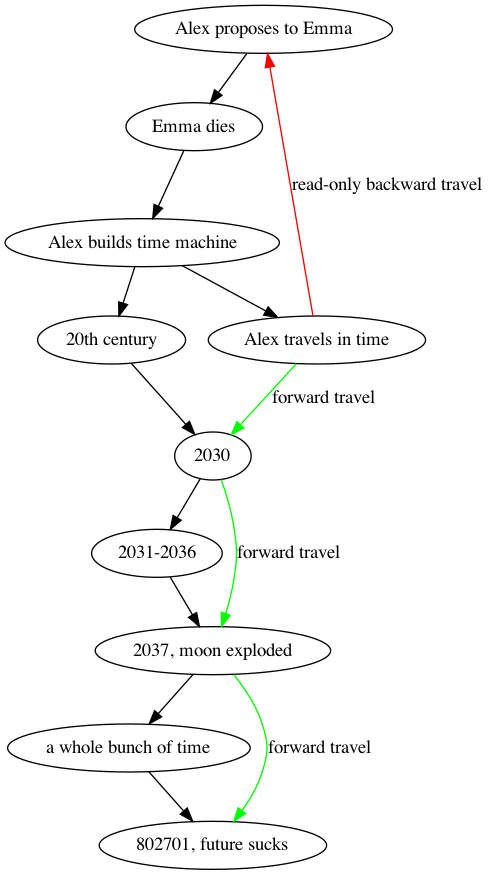The Topology of Time Travel Stories
Everyone needs an obscure useless skill. ‐ @Noahpinion
Mine is identifying the topology of time travel stories.
Click here if you know what topology is and just want to get to the time travel stuff
a brief introduction to topology
The original study of shapes was geometry, popularized by a Greek mathematician named Euclid. Starting about 2000 years after that, a Swiss mathematician named Euler (pronounced “Oiler”) accidentally inventented topology while trying to solve the Seven Bridges of Königsberg problem.
In a nutshell, geometry treats two shapes as ’the same’ if they can be rigidly transformed into one another. So, rotations, shifting around, and scaling the size doesn’t change the shape, according to geometry.
But distance is defined using real numbers, and real numbers come with a ton of baggage.
So topology studies a weaker notion of shape, where distances don’t matter. It can lead to some weird conclusions, like how every frame of this animation is actually the same:

In topology, this is like looking at a rotation, where the shape doesn’t change. The thing that is essential to topology is how things are connected.
the topology of non-time travel stories
Most stories are basic. There’s a beginning, middle, and end. The topology of most story timelines is a directed path:

This is literally every story. If you wanted to add a few more points to that directed path, you could make it more entertaining, but it would still be the same shape.
If you attach a number to each point on the path representing the sentiment (-1 = bad, 0 = neutral and 1 = good), then you can get a model like Kurt Vonnegut described in his great talk about the shapes of stories. I won’t get into emotion or sentiment in this post, but it’s worth watching to get a slightly more charitable take on all normal stories.
The Time Machine (2002)
The original time travel story was from H.G. Wells. I am going to use the 2002 movie adaptation of it because it is easier to follow, as the characters have actual names, and it’s a movie.
The plot: A guy named Alex proposes to his girlfriend Emma. A burglar steals his wallet, then tries to take the ring, she resists, the burglar shoots the girlfriend and runs off. Alex then does some math, builds a giant time machine, and goes back in time to save her. He takes her to a different place, but she dies again. Alex learns he can’t change big events in the past like life and death, so he decides to go to the future. He lands in 2030 and talks to a holographic librarian, asking him why can’t people change the past? The hologram laughs and says it’s not possible. Alex travels to 2037 and the moon has exploded and there’s an emergency police response, he jumps into his time machine and gets knocked out, and wakes up when the machine has traveled to the year 802,701. Humans have split into two species, one of them lives underground and is big and scary. This future is primitive and sad. But at least there are humans in it.
The topology of the timeline: Since the past can’t be changed in this movie, all backwards time travel doesn’t need to create a new timeline.

The far future in this story is interesting, because it explores how speciation might work with humans now. Even if some progress-destroying cataclysm like the moon exploding happpens, life will…. find a way.
Topologically, this story is not that interesting, but it’s better than most stories, since it involves loops and branching forward pathways.
Next steps:
- Stein’s Gate
- TENET
Email me if you want to see a movie or book involving time travel mapped out. I will happily do so.